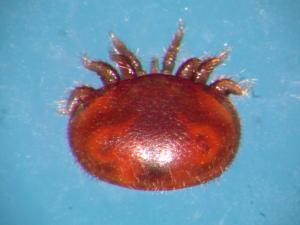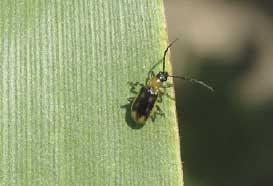[back]
[back] BayerHoney bees are dying all over
the globe. Here's why!
by Dan Eden for Viewzone
For over a year, the media has been reporting about the dramatic loss of bees
in Europe and North America. As many as 50% to 90% of the bee populations have
simply vanished, leaving their hives empty and forcing farmers to demand
investigations to determine the cause.
At first it was only the honeybees that were decimated -- then the bumblebee
populations began to disappear. Bumblebees are responsible for pollinating an
estimated 15 percent of all the crops grown in the U.S., worth $3 billion,
particularly those raised in greenhouses. Those include tomatoes, peppers and
strawberries. The crisis was eventually given a name: Colony Collapse Disorder
or CCD.
CCD is a "fake disease!"
 The most
popular theory, aside from the varroa mite [right] and cellphone RF radiation,
has been the belief that a virus -- similar to AIDS -- has infected the bees. A
team led by scientists from the Columbia University Mailman School of Public
Health, Pennsylvania State University, the USDA Agricultural Research Service,
University of Arizona, and 454 Life Sciences found a significant connection
between the Israeli Acute Paralysis Virus (IAPV) and colony collapse disorder (CCD)
in honey bees.
The most
popular theory, aside from the varroa mite [right] and cellphone RF radiation,
has been the belief that a virus -- similar to AIDS -- has infected the bees. A
team led by scientists from the Columbia University Mailman School of Public
Health, Pennsylvania State University, the USDA Agricultural Research Service,
University of Arizona, and 454 Life Sciences found a significant connection
between the Israeli Acute Paralysis Virus (IAPV) and colony collapse disorder (CCD)
in honey bees.
A team of scientists from Edgewood Chemical Biological Center and University
of California San Francisco identified both a virus and a parasite that are
likely behind the recent sudden die-off of honey-bee colonies. Using a new
technology called the Integrated Virus Detection System (IVDS), which was
designed for military use to rapidly screen samples for pathogens, ECBC
scientists last week isolated the presence of viral and parasitic pathogens that
may be contributing to the honeybee loss.
But it now appears that a much more basic culprit has killed the bees --
Bayer Corporation. Colony Collapse Disorder is poisoning with a known insect
neurotoxin called Clothianidin, a pesticide manufactured by Bayer, which has
been clearly linked to massive bee die offs in Germany and France.
Clothianidin = "Colony Collapse Disorder"
Here's the story. One of the most important crops is corn. It's used as a
feed for chickens and pigs and cattle. It's used in flour and in the production
of high fructose corn syrup. Just about everything we eat depends on corn.
Recently, with the energy crisis, corn has also been pressed to make ethanol to
run our cars. But corn has an enemy called the root worm.
(E)-1-(2-chloro-1,3-thiazol-5-ylmethyl)-3-methyl-2-nitroguanidine
Trade named: Poncho 600, Prosper and Elado, a Nitroguanidine subgroup of
nicotinoids produced by Bayer Corporation and registered in 2003.
 This
pesky bug, called diabrotica vergifera vergifera, [right] burrows in the newly
forming roots of the corn plant and causes the plant to wither and eventually
die. Farmers have long sought some type of pesticide to kill the bug and, in
2003, Bayer Pharmaceutical introduced a new product called Clothianidin. Their
own studies showed that this pesticide was highly toxic to bees but justified
the widespread use because it could be applied to corn seed and would be buried
in the soil where it would presumably be harmless to other creatures.
This
pesky bug, called diabrotica vergifera vergifera, [right] burrows in the newly
forming roots of the corn plant and causes the plant to wither and eventually
die. Farmers have long sought some type of pesticide to kill the bug and, in
2003, Bayer Pharmaceutical introduced a new product called Clothianidin. Their
own studies showed that this pesticide was highly toxic to bees but justified
the widespread use because it could be applied to corn seed and would be buried
in the soil where it would presumably be harmless to other creatures.
In theory, farmers were instructed to buy special machines that would coat
their seeds multiple times with clothianidin and a special adhesive, dry the
seeds, and then plant them. The poison is supposed to stick to the seed coat and
to be toxic to the rootworm as it attempts to burrow in to the newly forming
roots.
Bayer, who make the pesticide, and Monsanto, who make the adhesive, have
patented the method of coating their proprietary seeds with clothianidin, which
are now growing all over the globe.
Oooooops!
The first clue that Colony Collapse Disorder was a simple case of poisoning
-- similar to the DDT bird kill-off decades ago -- was when clothianidin was
used on corn crops in Germany's Baden-Wuerttemberg state.
 In July of
2007, the German crop was infested with the rootworm. The German government
ordered that every possible method should be used to eradicate this pest,
including the use of clothianidin. Shortly after the seeds were planted, in May
of 2008, some 330-million bees abruptly died!
In July of
2007, the German crop was infested with the rootworm. The German government
ordered that every possible method should be used to eradicate this pest,
including the use of clothianidin. Shortly after the seeds were planted, in May
of 2008, some 330-million bees abruptly died!
According to the German Research Center for Cultivated Plants, 29 out of 30
dead bees had been killed by direct contact with clothianidin.
Philipp Mimkes, spokesman for the German-based Coalition Against Bayer
Dangers, said: "We have been pointing out the risks of neonicotinoids for almost
10 years now. This proves without a doubt that the chemicals can come into
contact with bees and kill them. These pesticides shouldn't be on the market."
An investigation revealed that the seed coating did not stay in the soil but
was introduced to the air (and the rest of the plant) by simple abrasion -- the
rubbing together of seeds -- as they are stored, moved and injected in to the
soil by farming machines.
German authorities suggested that the seeds were not treated with a special
polymer, called a "Sticker," which makes the pesticide adhere to the seed. But
it is noted also that the formulation of clothianidin does not require this
"sticker" in typical applications and most farmers find this additional coating
too cost prohibitive.
The German government quickly banned this pesticide and gave compensation to
the farmers and issued a strong warning against using this chemical in
agriculture. According to the German Federal Agriculture Institute,
"It can unequivocally be concluded that poisoning of the bees is due to
the rub-off of the pesticide ingredient clothianidin from corn seeds."
According to the U.S. Environmental Protection Agency (May 30, 2003):
"Clothianidin has the potential for toxic chronic exposure to honey bees,
as well as other nontarget pollinators, through the translocation of
clonianidin redidue in nectar and pollen."
[In the same report] "The fate and disposition of clothianidin in the
environment suggest a compound that is asystemic insecticide that is
persistent and mobile, stable to hydrolysis, and has potential to leach to
ground water, as well as runoff to surface waters."
"Clothianidin is highly toxic to honey bees on an acute contact basis
(killing 50% of tested populations at greater than 389 mg/kg). It has the
potential for toxic chronic exposure to honey bees, as well as other
nontarget pollinators, through the translocation of clothianidin residues in
nectar and pollen. In honey bees, the effects of this toxic chronic exposure
may include lethal and/or sub-lethal effects in the larvae and reproductive
effects in the queen."
Clothianidin = neurotoxin
The cigarette industry used to brag that one or two cigarettes doesn't give a
person lung cancer. Likewise, the pharmaceutical companies are quick to show
that feeding bees a specific amount of neurotoxins, like clothianidin, doesn't
kill the bees. And, of course, this is true.
While small traces of clothianidin may not kill bees outright, it can and
apparently does interfere with their ability to navigate to and from the hive.
The pollen that they manage to bring back to the hive is then further
concentrated and exposed to the entire colony, causing suppression of their
immune systems and subsequent infection by any number of parasites and
pathogens. This is exactly what beekeepers and farmers have been reporting --
half empty, infested bees or abandoned hives with no dead bodies to be found
anywhere. It has also been noted that the empty colonies are absent the usual
parasitic bugs that typically take advantage of an abandoned hive. The colonies
appear sterile.

People dressed as bees demonstrate against pesticides 21 April 2007 in front
of the Bayer headquarters in Brussels. Three millions bees have been dying each
year since the introduction on the market of the pesticide manufactured by
Bayer.
Poster reads :'Gaucho Bayer, only kills if one uses it.'
Not Just Corn
The tragedy in Germany and France showed that bees who became exposed to
clothianidin also infected bee colonies that were not harvesting corn pollen,
thus spreading the toxin to regions at some distace to areas cultivating corn
plants. It is theorized that they could have become disoriented and mingled with
bees from other colonies or contaminated the pollen of plants where other bee
colonies were also pollenating.
Same old story...
 Money
talks. Agro-business is huge and their influence is deep in the sciences and
politics. Their own scientists must know very well that their product has
threatened the global population of bees, yet they allow the conspiracy theories
of a mysterious "Colony Collapse Disease" to endure. Clothianidin and
imidacloprid (another pesrticide also banned by Germany and France) account for
much of Bayer's agrochemical profits.
Money
talks. Agro-business is huge and their influence is deep in the sciences and
politics. Their own scientists must know very well that their product has
threatened the global population of bees, yet they allow the conspiracy theories
of a mysterious "Colony Collapse Disease" to endure. Clothianidin and
imidacloprid (another pesrticide also banned by Germany and France) account for
much of Bayer's agrochemical profits.
I used to think of Bayer as the company that made aspirin and medicine, but I
recently saw a list of poisons that they made and marketed to kill everything
from microbes to insects. It seems odd to me that a company that makes poisons
also makes medical cures... Is there a link there? Perhaps it's just different
sides of the same dollar or Euro.
UPDATE
(08-18) 18:37 PDT -- The U.S. Environmental Protection Agency is refusing to
disclose records about a new class of pesticides that could be playing a role in
the disappearance of millions of honeybees in the United States, a lawsuit filed
Monday charges.
The Natural Resources Defense Council wants to see the studies that the EPA
required when it approved a pesticide made by Bayer CropScience five years ago.
The environmental group filed the suit as part of an effort to find out how
diligently the EPA is protecting honeybees from dangerous pesticides, said Aaron
Colangelo, a lawyer for the group in Washington.
In the last two years, beekeepers have reported unexplained losses of hives -
30 percent and upward - leading to a phenomenon called colony collapse disorder.
Scientists believe that the decline in bees is linked to an onslaught of
pesticides, mites, parasites and viruses, as well as a loss of habitat and food.
$15 billion in crops
Bees pollinate about one-third of the human diet, $15 billion worth of U.S.
crops, including almonds in California, blueberries in Maine, cucumbers in North
Carolina and 85 other commercial crops, according to the U.S. Department of
Agriculture. Not finding a cause of the collapse could prove costly, scientists
warn.
Representatives of the EPA said they hadn't seen the suit and couldn't
comment.
Clothianidin is the pesticide at the center of controversy. It is used to
coat corn, sugar beet and sorghum seeds and is part of a class of pesticides
called neonicotinoids. The pesticide was blamed for bee deaths in France and
Germany, which also is dealing with a colony collapse. Those two countries have
suspended its use until further study. An EPA fact sheet from 2003 says
clothianidin has the potential for toxic chronic exposure to honey bees, as well
as other pollinators, through residues in nectar and pollen.
The EPA granted conditional registration for clothianidin in 2003 and at the
same time required that Bayer CropScience submit studies on chronic exposure to
honeybees, including a complete worker bee lifecycle study as well as an
evaluation of exposure and effects to the queen, the group said. The queen,
necessary for a colony, lives a few years; the workers live only six weeks, but
there is no honey without them.
"The public has no idea whether those studies have been submitted to the EPA
or not and, if so, what they show. Maybe they never came in. Maybe they came in,
and they show a real problem for bees. Maybe they're poorly conducted studies
that don't satisfy EPA's requirement," Colangelo said.
http://viewzone.com/lostbees.bayer.html
 The most
popular theory, aside from the varroa mite [right] and cellphone RF radiation,
has been the belief that a virus -- similar to AIDS -- has infected the bees. A
team led by scientists from the Columbia University Mailman School of Public
Health, Pennsylvania State University, the USDA Agricultural Research Service,
University of Arizona, and 454 Life Sciences found a significant connection
between the Israeli Acute Paralysis Virus (IAPV) and colony collapse disorder (CCD)
in honey bees.
The most
popular theory, aside from the varroa mite [right] and cellphone RF radiation,
has been the belief that a virus -- similar to AIDS -- has infected the bees. A
team led by scientists from the Columbia University Mailman School of Public
Health, Pennsylvania State University, the USDA Agricultural Research Service,
University of Arizona, and 454 Life Sciences found a significant connection
between the Israeli Acute Paralysis Virus (IAPV) and colony collapse disorder (CCD)
in honey bees.  This
pesky bug, called diabrotica vergifera vergifera, [right] burrows in the newly
forming roots of the corn plant and causes the plant to wither and eventually
die. Farmers have long sought some type of pesticide to kill the bug and, in
2003, Bayer Pharmaceutical introduced a new product called Clothianidin. Their
own studies showed that this pesticide was highly toxic to bees but justified
the widespread use because it could be applied to corn seed and would be buried
in the soil where it would presumably be harmless to other creatures.
This
pesky bug, called diabrotica vergifera vergifera, [right] burrows in the newly
forming roots of the corn plant and causes the plant to wither and eventually
die. Farmers have long sought some type of pesticide to kill the bug and, in
2003, Bayer Pharmaceutical introduced a new product called Clothianidin. Their
own studies showed that this pesticide was highly toxic to bees but justified
the widespread use because it could be applied to corn seed and would be buried
in the soil where it would presumably be harmless to other creatures.  In July of
2007, the German crop was infested with the rootworm. The German government
ordered that every possible method should be used to eradicate this pest,
including the use of clothianidin. Shortly after the seeds were planted, in May
of 2008, some 330-million bees abruptly died!
In July of
2007, the German crop was infested with the rootworm. The German government
ordered that every possible method should be used to eradicate this pest,
including the use of clothianidin. Shortly after the seeds were planted, in May
of 2008, some 330-million bees abruptly died! 
 Money
talks. Agro-business is huge and their influence is deep in the sciences and
politics. Their own scientists must know very well that their product has
threatened the global population of bees, yet they allow the conspiracy theories
of a mysterious "Colony Collapse Disease" to endure. Clothianidin and
imidacloprid (another pesrticide also banned by Germany and France) account for
much of Bayer's agrochemical profits.
Money
talks. Agro-business is huge and their influence is deep in the sciences and
politics. Their own scientists must know very well that their product has
threatened the global population of bees, yet they allow the conspiracy theories
of a mysterious "Colony Collapse Disease" to endure. Clothianidin and
imidacloprid (another pesrticide also banned by Germany and France) account for
much of Bayer's agrochemical profits.